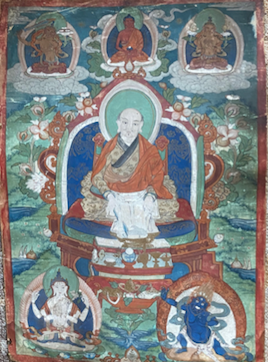
Submitted by Admin on Tue, 06/07/2021 - 16:08
The Mongolia and Inner Asia Studies Unit is very pleased to announce that the third Onon Prize has been awarded to Professor Christopher Atwood, for his outstanding contributions to Inner Asian Studies.
Professor Atwood is the recipient of the prize for 2020, the award having been postponed.
The Onon Prize was established in recognition of Professor Urgunge Onon’s contribution to the foundation of MIASU. The prize is intended to honour those who have made a substantial contribution to scholarship on the Mongolian & Inner Asian region
Christopher P. Atwood was introduced to Mongolian and Chinese studies by Joseph Fletcher and Francis W. Cleaves, receiving his A.B. from Harvard University in 1986. He spent two years in Inner Mongolia, doing research and studying at the Mongolian language and literature department at Höhhot’s Inner Mongolia Normal University. He completed his Ph.D. from Indiana University’s Central Eurasian Studies Department, working with György Kara, Lynn Struve, Elliot Sperling, and Jeff Wasserstrom. He went on to teach at Indiana University for two decades, serving as department chair and interim director of the Center for Languages of the Central Asian Region, before taking up his current position as first Professor and then Chair of Department of East Asian Languages and Civilisations at the University of Pennsylvania in 2016. He has authored over a hundred publications, including the authoritative reference work Encyclopedia of Mongolia and the Mongol Empire (2004), the Rise of the Mongols: Five Chinese Sources (2021), and the two-volume work Young Mongols and Vigilantes in Inner Mongolia Interregnum Decades, 1911-1931 (2002). Professor Atwood is a recipient of the Order of the Polar Star, awarded by the President of Mongolia, and holds honorary doctorates from the Academy of Sciences and the National University of Mongolia.
THE ONON PRIZE 2020 AND LECTURE BY PROFESSOR CHRISTOPHER ATWOOD
The Mongolia and Inner Asia Studies Unit was delighted to award the Onon Prize 2020 to Professor Christopher Atwood (University of Pennsylvania) for his stellar contribution to Mongolian Studies. Professor Atwood’s work has covered an extraordinarily wide range of themes, from political history to studies of ritual and environmental studies. His many publications are often pathbreaking and they are always achieved with originality, exemplary scholarship and linguistic acumen. His Encyclopaedia of Mongolia and the Mongol Empire (2004) has become an indispensable reference volume for generations of researchers. Atwood’s most recent book is Rise of the Mongols: Five Chinese Sources (2021). We look forward now with great anticipation to an important event in our field, Professor Atwood’s new translation of the Secret History of the Mongols, published by Penguin in 2023.
Because of pandemic restrictions, the award of the 2020 prize was delayed to December 2022. On the occasion of his visit to Cambridge, Professor Atwood kindly agreed to give a public lecture. Entitled The Feminine in the Secret History of the Mongols the lecture argued that although the Mongols at the time of Chinggis Khan are usually associated with warlike masculinity the text gives unexpectedly large place to female characters and their influence. Furthermore, the anonymous Secret History details women’s thoughts, feelings and subjectivity. This led Professor Atwood to ask the teasing question “Could the author actually have been a woman?” The lecture was enthusiastically received and generated a lively discussion.
A note on the Onon Prize
The Onon Prize for 2020 consisted of a small original thangka painting of Zanabazar (1635-1723), the first Bogd Gegen of Mongolia. A popular work painted at unknown date, this small thangka is nevertheless interesting for the unusual pose in which it depicts the Buddhist spiritual leader. In most thangkas, including the majority of those of Zanabazar, holy figures are shown in standard poses holding symbolic religious objects, but in this case the Bogd Gegeen is shown holding a knife, with which he is cutting a slice from the fat rump of a sheep. We have discovered two explanations of this unorthodox image. The first we cite from Uranchimeg Tsultemin’s book A Monastery on the Move: Art and Politics in Later Buddhist Mongolia (2021, University of Hawai’I Press, page 33). She writes that this image was an unofficial (engiin) Mongol portrait. It was based on an oral legend and examples of it were intended to be seen, owned, and worshipped by Mongol devotees. The legend was as recounted first by S. Ichinorov, a modern Mongolian historian, and later by L. Khürelbaatar.
“As the legend goes, Zanabazar’s disciples asked their master what imagery of him would be appropriate to worship. Zanabazar allegedly replied that his “learned image” should show him seated in a Mongolian robe clasping a sword of knowledge in his right hand, akin to Manjushri and holding fat from a sheep’s tail in his left hand, in keeping with an old Mongolian head-of-household tradition.69 These “attributes” would symbolize to his disciples the attainment of enlightenment by defeating the darkness of ignorance (with the sword) and would perpetuate his authority as leader. In the Mongolian perception, only a chief, a leader, has the right to slice a sheep’s tail to commence a feast and celebration. This tradition served as the basis for the woodblock print and closely aligns with what the tradition had prescribed. The medium of a woodblock print suggests the portrait was intended to be widely distributed. Indeed, numerous thangka paintings, ranging in size from intimately small for private viewing to large thangkas portray Zanabazar slicing a sheep’s tail.”
A footnote adds that there is an old Mongolian tradition of presenting sheep tail fat during various celebrations and feasts. The tradition has been preserved up to the present day. Only the head of the family has the authority to cut the first slice of the tail fat.
A different legend was recounted to us by MIASU member, Dr. Khürelbaatar Üjeed. He recalls being told the following by a Mongolian intellectual in the 1980s in Ulaanbaatar. Zanabazar took refuge in China when the Jungars raided Mongolia at the end of the 17th century. He remained in effect under house arrest in Beijing for years. Longing for his native land and its lifestyle, he sat in front of a mirror and painted his own self-portrait. The knife in his hand had nothing to do with wisdom: it was the ordinary carving knife used when a Mongol person cuts off a piece of meat to put in his mouth. The painting was not meant to convey the authority of a leader engaged in a social ritual act. Zanabazar was just cutting the fat for himself. The image represented the simple act of eating in a Mongol way, which was so unlike Chinese custom both in the type of food and the utensil used. The cut of meat shown should not correctly be described as a sheep’s tail but rather as the entire fatty rump, called in Mongolian uuts.
Read more about previous Onon prizes here

